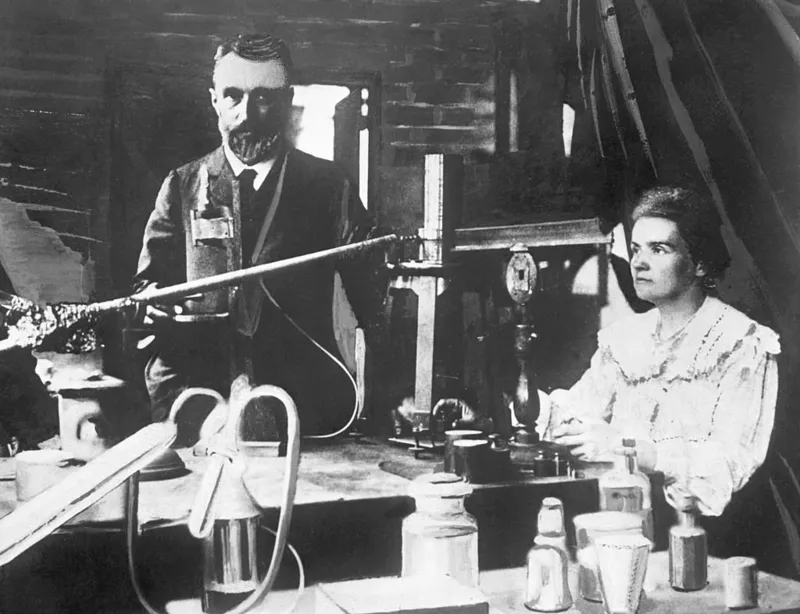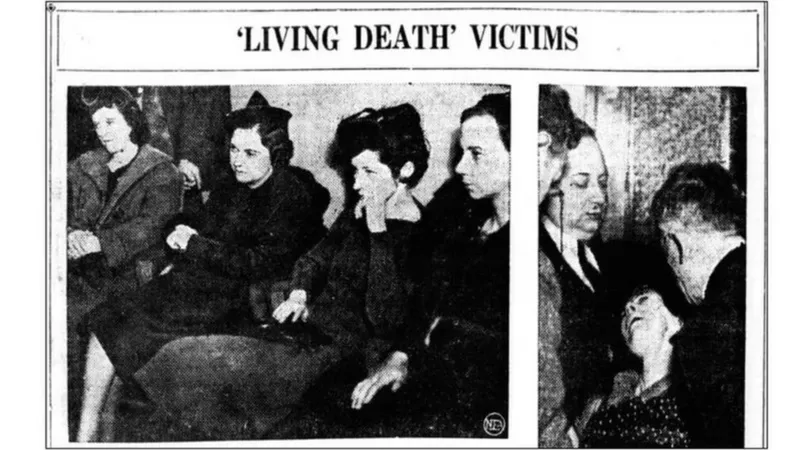Grace began working in a factory in the spring of 1917, along with 70 other women. It was one of many factories to be established across the United States at the start of World War I. The factory was used to illuminate the dials of watches and military wristwatches so that they could be seen in the dark (with the help of Radium).

Researcher Arlene Balkansky reports that hundreds of women were excited about the job. After America entered World War I on April 6, 1917, some women took up this job as an expression of their patriotism. They painted panels of glow-in-the-dark clock dials and military equipment for soldiers.
Radium is an element that glows in the dark. French scientists Marie and Pierre Curie discovered radium in 1898.
Considered a miracle substance
Since radium was successfully used in the treatment of cancer, many considered it a miracle substance. Hence it is included in various commercial products including toothpastes and cosmetics.
Women working in factories making clock dials mixed radium powder with glue and water to make a luminous white paint. Then the clock dial and its numerals are carefully painted with a brush made of camel hair. After some use, the brush will wear out. Then they can't paint properly.
"Our supervisor would tell me to rub the tip of those brushes with my lips to sharpen them. I think I adjusted the brush with my lips six times to paint each clock dial. The paint didn't taste any different. It didn't have any flavor. I didn't know it was harmful," Grace says.
The girls thought it would do no harm.
The women who painted the dial were also known as 'Ghost Women'. Encyclopaedia Britannica states that their clothes, hair and skin became shiny as radium particles fell on them daily.
Many women came to work in their best clothes so that the clothes would shine when going out after work.
Some women apply this color to their teeth to make them appear brighter when they smile. Some even surprise their lovers with the glitter of their nails.
When asked about the safety of radium, their manager also assured them that there was nothing to worry about.
Of course, this is not true.
It didn't take long for the 'Radium Girls' to take a physical toll. Its first victim was Amelia (Molly) Magia. He designed clocks for the Radium Luminous Materials Corporation (later the United States Radium Corporation) in Orange, New Jersey.
The first symptom is a toothache. For that all the teeth had to be removed one after the other. Soon painful sores oozing with blood and pus took the place of the shiny teeth.
Amelia's mouth was covered with a mysterious disease. The lower jaw had to be amputated. Then the infection spreads to other parts of the body. He died on 12 September 1922 due to profuse bleeding.
The cause of death could not be ascertained
Doctors couldn't find the cause of death, so surprisingly they said he died of an unknown cause.People had a misconception that radium was safe. Radium women began to succumb to deadly diseases in large numbers.
Grace left the factory for a bank job in 1920, but after about two years, her teeth also started to fall out. A painful sore appeared on his jaw. Finally in July 1925 a doctor suggested that these problems might be due to his previous work.
In 1924, Cecil Drinker, a professor of physiology, suggested changing working conditions to protect the welfare of workers. But Arthur Roeder, president of the US Radium Organization, not only rejected this, but asked for evidence. But it didn't happen.
In 1925, pathologist Harrison Martland conclusively demonstrated that radium poisoned women who painted watches.

Four other women with serious medical problems, Edna Hussman, Katherine Schaap, and two of Amelia Magia's sisters, Quetta MacDonald and Albina Laures, joined the suit. Each of them asked for 2.5 lakh dollars as compensation for medical expenses and sickness.
News clipping.
At the request of the sisters, Amelia's body was exhumed on October 16, 1927. An autopsy confirmed that his bones were very shiny. It is discovered that Amelia died of a new and mysterious form of necrosis. It had also affected his sisters badly.
Dubbed the 'Radium Girls' by the world press, the five women were unable to even raise their hands to take the oath at the first trial in January 1928.
Freire and the other girls tried to keep smiling bravely. But their friends and others in court cried, New York Leisure newspaper reported.
The above-mentioned matters about Grace are part of the statement submitted to the same court.
Marie Curie offered to help
By April these women were neither physically nor mentally fit to appear in court to attend the second trial.
When Marie Curie, the French scientist who discovered radium, read about the case, she said, 'French radium workers used small cotton-wrapped sticks instead of paintbrushes,' the New York Journal reported.
"I would be more than happy to provide any assistance. But once this material enters the human body there is no way to remove it," Currie said.
The inquest on 25 April 1928 was adjourned to September, despite Attorney Perry stating that the women were dying and unlikely to survive until the next inquest.
The adjournment of the case drew strong condemnation in the newspapers.
Walter Lippmann, editor of the New York World, opined in a May 10, 1928 editorial, "The decision to delay the trial is 'a great injustice.' There is no reason for such a delay. Women are dying. The case of these five sick women who are fighting for a few dollars to ease their last days on earth must be decided soon." wrote that The court then adjourned the trial to early June 1928.
However, a federal judge offered to mediate the dispute out of court. A few days before the trial, the Radium Girls agreed to a stipend of $10,000 each and $600 a year. It is also agreed that all medical and legal expenses will be borne by the company.
Perry was unhappy with the settlement, feeling that "the corporation was benefiting greatly from it." He also doubted U.S. District Court Judge William Clark, who acted as mediator.
'I am sure he is a very respectable person and genuinely cares about social issues,'. But 'his life shows he's on the corporate side,' said Perry.
Perry learns that Judge Clark owns stock in the American Radium Corporation.
Radium
All five Radium women, who received a small amount of compensation, died in the following months and years.The original inventor of radium paint, Austrian physician Sabin A. Von Suchowky died in Orange, New Jersey, on November 14, 1928, the New York Times reported.
But a later lawsuit confirmed that it could cause death.
The suit was filed by Catherine Wolfe Donohue against the Radium Dial Company of Ottawa. Newspapers published his photographs after his death.
After several hearings before the Illinois Industrial Commission, Ottawa's Radium Girl won the case in 1938.
Radium Dial Company filed several appeals. On October 23, 1939, the U.S. Supreme Court declined to hear the company's final appeal and upheld the lower court's decision.
The verdict was announced. But the effect of radium is not going away anytime soon. Commenting on the Donohue Affair, Marion Kenig noted a female relative in her late 40s who died on her first wedding day.
Within a year, the woman was buried in her loose wedding dress.
Arlene Balkanski noted that Kathryn Wolfe Donohue was one of several women who died before the cases were resolved. He died on 27 July 1938. But her legal battle led to the establishment of occupational safety and health guidelines for women who came after her.
The radium industry tried to discredit Martland.
Grace Freer decided to file a lawsuit. But it took him two years to find a lawyer.
On May 18, 1927, he sued the American Radium Corporation in a New Jersey court through a young attorney, Raymond Perry.

0 Comments